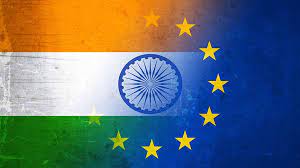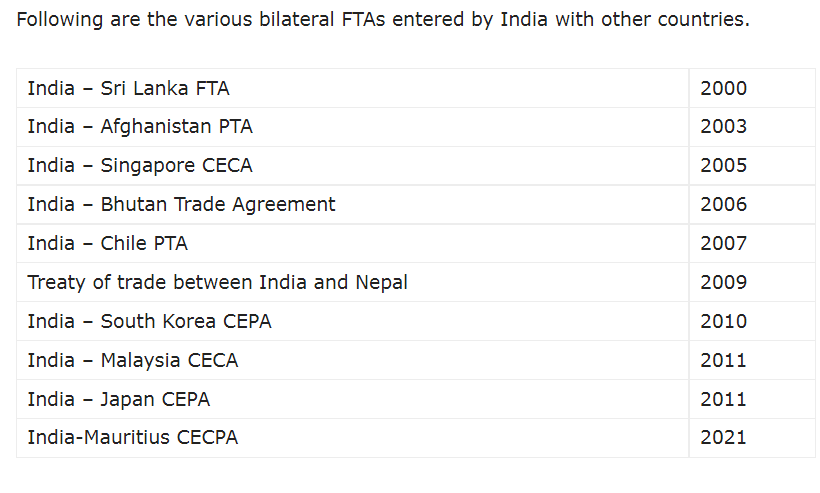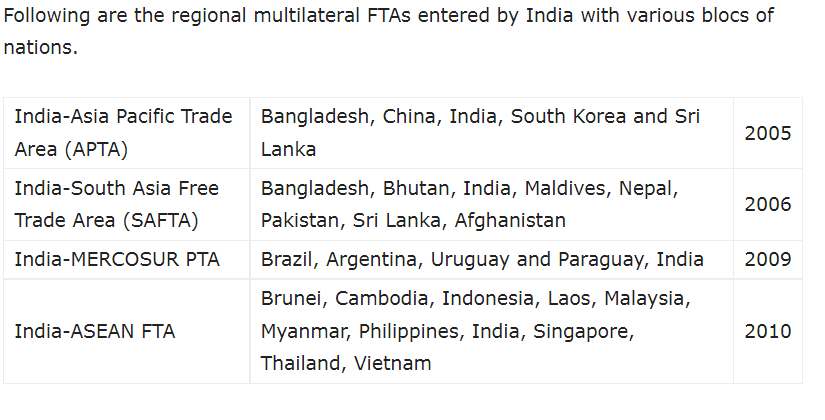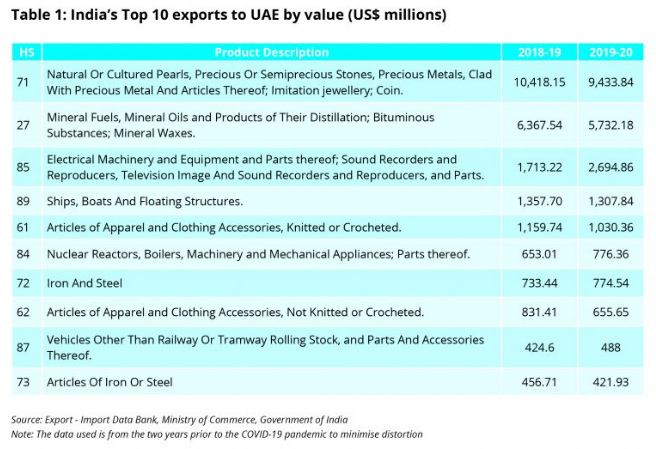
Disclaimer: Copyright infringement not intended.
Context
- The Netherlands intends to support a free trade agreement (FTA) between India and the European Union, the Netherlands Foreign Minister Wopke Hoekstra said.
What Is a Free Trade Agreement (FTA)?
- A free trade agreement is a pact between two or more nations to reduce barriers to imports and exports among them. Under a free trade policy, goods and services can be bought and sold across international borders with little or no government tariffs, quotas, subsidies, or prohibitions to inhibit their exchange.
- FTAs usually cover trade in goods (such as agricultural or industrial products) or services (such as banking, construction, trading).
- FTAs can also cover other intellectual property rights (IPRs), investment, government procurement and competition policy.
- There are various other arrangements except FTA undertaken by bodies to liberalize the trade between them, namely Preferential Trade Agreement (PTA), Comprehensive Economic Cooperation Agreement (CECA), Comprehensive Economic Partnership Agreement (CEPA), Customs Union (CU), Custom Market (CM) and Economic Union (EU).
The concept of free trade is the opposite of trade protectionism or economic isolationism.
How a Free Trade Agreement Works
- In the modern world, free trade policy is often implemented by means of a formal and mutual agreement of the nations involved.
- For example, a nation might allow free trade with another nation, with exceptions that forbid the import of specific drugs not approved by its regulators, or animals that have not been vaccinated, or processed foods that do not meet its standards.
Advantages and Disadvantages of Free Trade Agreement
Pros:
1) Comparative Advantage: The idea that everyone benefits when countries produce and sell freely what they do most efficiently. In other words, everyone should specialize in what they do best and governments should intervene as little as possible in the process.
2) Protectionism is expensive: Basically, tariff and non-tariff barriers (NTBs) result in higher prices for consumers. Barrier costs are passed on to consumers, or consumers are forced to buy more expensive domestically produced goods.
3) Competition: The idea that competition fosters lower prices, efficiency in production, and innovation.
4) Functionalism: The argument that cooperation in one area (such as trade) promotes cooperation in other areas. In theory, the drug problem, immigration problems, etc. are more forthrightly addressed.
5) Interdependence: The idea that free trade leads to interconnections that make conflict too costly. In other words, dependency undercuts the likelihood of war. (Europe is a commonly cited example).
6) Economic Growth: Because free trade promotes economic growth, pressing social problems, such as unemployment, environmental deterioration, or illegal immigration can be alleviated.
7) Defense against protectionism elsewhere: Regional free trade agreements help offset the danger of protectionism elsewhere and secure markets for exporters. In other words, they give leverage against other large economic entities, like the European Union.
8) Introduction of capital and technology: For poorer countries, free trade can promote the introduction of capital and technology into their economies.
9) Democratization: Some think free trade even promotes democracy because it promotes discipline and transparency.
Cons:
1) Threats to domestic industries/jobs: Most mainstream economists want to dismiss these threats because they say free trade also creates jobs and growth. But labor unions and domestic industries use this argument to push protectionism. Clearly, free trade agreements can cause dislocations, and attendant ripple effects, in an economy, even if they create a bigger economic pie.
2) Infant Industries: Poorer countries have argued that they needed to protect “infant industries” so they can get them off the ground in the first place. Most economists see this as a valid argument, but argue that it then becomes hard to take the protections off.
3) Too much dependency on a few products: Specialization through comparative advantage could make an economy (especially a smaller economy) too dependent on a few resources or products. If demand falls in those areas, economic catastrophe could ensue.
4) Nice free traders can finish last: In the real world there are governments which control exports and imports, heavily subsidize their producers, or erect NTBs which limit trade. In this world, nice free traders can finish last. The US allowed discriminatory practices from others after WWII, but fights them now that it no longer represents the majority of the world economy.
5) Security is endangered: Protectionists sometimes argue that a country should not become so dependent that it cannot defend itself. For example, the US should not let its shipbuilding industry die simply because ships can be built cheaper in other places. Steel is another example.
6) Cultural Imperialism: Similarly, countries in Latin America and elsewhere (France is commonly cited) worry about cultural imperialism (Hollywood; rock and roll bands) and the loss of historic industries (French wines).
7) Trade is a powerful policy tool: When dealing with other countries trade leverage should not be given up because of a belief in economic rationalism. Similarly, we should not give up our sovereignty over trade matters to regional or international bodies. They shouldn’t be able to claim our laws are unfair barriers to trade.
8) Harmonization downward: Free trade could force countries to lower their environmental, labor, or other standards in order to compete. Also, such standards could be declared unfair trade practices by regional or international bodies.
India and FTAs
- India has been talking free trade agreements with several partners – both bilateral and regional – over the past two years in a bid to boost export-oriented domestic manufacturing.
- New Delhi has set an ambitious export shipment target of US$450-$500 billion by FY23.
- Our current FTAs are with Sri Lanka, Singapore, ASEAN, Malaysia, Japan and Korea. We are also part of South Asia FTA, covering Pakistan, Nepal, Bangladesh and other countries in the region.
- FTAs with Canada, Australia, UAE, Israel and now with the UK are in different stages of negotiations.
Left RCEP
- India pulled out of the RCEP in 2019 citing risks to protecting the interests of its domestic manufacturers.
- A similar situation has played out with other trade agreements with India believing that its domestic industry has benefitted less than that of the counter signatories.
- Still, signing new FTAs and renegotiating existing trade agreements for more favourable terms is one way of mitigating the impact of leaving the RCEP.
|
The Regional Comprehensive Economic Partnership is a free trade agreement among the Asia-Pacific nations of Australia, Brunei, Cambodia, China, Indonesia, Japan, South Korea, Laos, Malaysia, Myanmar, New Zealand, the Philippines, Singapore, Thailand, and Vietnam.
|


India-EU FTA
- India is re-launching talks with the European Union (EU) on a proposed free trade agreement (FTA).
- The EU’s key demands include duty concessions for automobiles, dairy products, and wines and spirits.
- The EU also wants India to cover concessions extended to other FTA partner nations.
- India, is demanding for greater market access in financial services and mobility for professionals. As part of the FTA, India wants the EU to conclude agreements on investment protection and geographical indicators with the EU accounting for nearly 15% of Indian exports.
- The 27-member bloc accounts for 8.5% of India’s imports.
Genesis
- The India-EU FTA talks -- or the Broad-Based Trade and Investment Agreement as it is officially called -- started in 2007 in Brussels, Belgium.
- These negotiations are pursuant to the commitment made by political leaders at the 7th India-EU Summit held in Helsinki in 2006 to move towards negotiations for a broad-based trade and investment agreement .
- But the negotiations were put on hold in 2014 following differences over sensitive non-trade issues such as environment and labour standards.
Areas of Negotiation
- The negotiations cover Trade in Goods, Trade in Services, Investment, Sanitary and Phytosanitary Measures, Technical Barriers to Trade, Trade Remedies, Rules of Origin, Customs and Trade Facilitation, Competition, Trade Defence, Government Procurement, Dispute Settlement, Intellectual Property Rights & Geographical Indications, Sustainable Development.
Implications of FTA
- The India-EU FTA is going to be a game changer in terms of capacity of trade increase between them.
- FTA between India and the EU will help bring down import duties and create a level playing field for European firms.
- The most important part of the FTA is to standardize norms. This will make doing business easier for both sides.
- From the Austrian perspective, a number of Indian companies such as Mahindra and ITC and several IT companies are using Vienna as their hub for European countries. More firms can be set up base in Vienna as Australia shares a very special relationship with East European countries and has a high degree of connectivity. So if Indian companies set up their bases in Vienna, they can reach all of Europe within one hour.
- Ireland is looking at gains in pharmaceuticals and whiskeys from the proposed FTA.
FTA between India and the UAE
- The free trade agreement between India and the UAE is likely to come into effect from May 1, 2022.
- The Comprehensive Economic Partnership Agreement (CEPA) was signed by India and the United Arab Emirates (UAE) in February 2022 which aims to boost bilateral trade to USD 100 billion in the next five years from current USD 60 billion.
Areas of Negotiation
- Domestic exporters of as many as 6,090 goods would get duty-free access to the UAE market.
- Immediate duty-free access covers all labour-intensive sectors such as gems and jewellery, textiles and apparel, agricultural and fish products, leather, footwear, and sport goods, Pharmaceuticals and Medical devices, and many engineering products.
- Key areas of India's interest are computer related services, audio visual, education, health, tourism, travel, professionals services like nursing, engineering, and accountancy.
- India has offered significant concessions on goods of export interest to the UAE and that include dates, petroleum products (crude, LPG, Naptha ), petrochemicals (polyethylene, polypropylene and poly vinyl chloride), metals (aluminium, copper, nickel, iron and steel), minerals (limestone, cement).
Future prospects
- India is also working for mutual recognition agreements (MRAs) of professionals and skilled services, so that if UAE approve India’s nursing colleges then the nursing degree from that college will get automatic recognition here and vice versa.
- Another part of the agreement is the agreement on e-commerce and digital trade.
- It is not the first time that India has included an e-commerce chapter in an FTA, but the rules have never pushed the bounds of liberalisation beyond World Trade Organisation (WTO) requirements. It will do so now.
|
As part of protective measures in the pact, there are strict Rules of Origin (RoO) criteria that reflect the requirement for substantial processing of up to 40 per cent for most of the products and wholly obtained criteria for agricultural products.
|
Implications
- Currently, we are exporting about USD 26 billion worth of goods to the UAE , almost 90 per cent of them will get total tariff (or customs duty) elimination on Day 1 itself.
- Going forward in the next 5-7 or ten years, the rest of the 9.5 per cent (about 1,270 goods) will also get zero duty.
- On the other hand, India will be giving duty-free access to 7,694 goods on the day of implementation of the agreement. Around 2,400 goods would get zero duty in 5-10 years time period.
- Overall, the India–UAE CEPA if implemented correctly, it will be a valuable tool in the hands of Indian industry, for whom the UAE, and by extension the Gulf, is a familiar market.
- India–UAE CEPA serves the purpose of reducing uncertainty and political risk between two important trade partners. The CEPA is very ambitious on tariff reduction.
- India–UAE CEPA is crucial to India’s geoeconomic strategy. The UAE, and by extension the Gulf Cooperation Council region, is a natural partner for this, given that the countries share complementarities when it comes to trade.
- According to the International Trade Centre’s Export Potential Map, India has about US$10.1 billion of untapped goods trade potential with the UAE.

Expansion of FTAs in India
- India has closed its major chance of being a part of the governing party with its main trading partners by declining the entry into RCEP.
- The RCEP is supposed to be the largest trade agreement in the world with 15 economies, out of which India faces a trade deficit with 11 of them. This includes the countries with whom India has already signed an FTA but haven’t shown any sign of progress such as Japan, South Korea and ASEAN and other promising countries with whom an agreement is under negotiations such as Australia and New Zealand.
- One of the reasons for the last moment back out of India was the supposed liberalization of trade between China and India through RCEP. India already faced a trade deficit of USD 54.7 billion in 2018 and a further reduction in tariff would have worsened it.
- India must look for reforms to reap full benefits out of the FTAs to reduce the trade deficit on a long-term basis.
Detrimental FTAs of India
- India’s exports to FTA countries have underperformed the exports to the rest of the world. The trade deficit of India, with exports of USD 30.21 billion and imports standing at USD 45.45 billion, was at USD 15.24 billion in April 2021 which is a 120.34% jump.
- India has underutilized the FTA less than 25% and according to a Deloitte report, it is even less than 3%.
- The underutilization can be due to the lack of awareness about FTAs and rules of origin, high compliance cost and absence of trade negotiations.
- The ASEAN, South Korea and Japan agreements have proven detrimental to India. The report from think-tank Third World Network says that the trade deficit of India with the three partners has been increasing and a progressive slowdown in exports.
Way Ahead
- India needs to approach FTAs strategically and must think about mutual benefits or win-win situations.
- Every FTA entered by India has necessarily not benefitted or has given results as expected. In fact, there are very few FTAs that have shown a positive curve, otherwise, other FTAs are either stagnant or have a trade deficit.
- The reasons for the trade deficit should be examined and the sector-specific measures need to be taken to gain from future trade deals should be explored.
- India should review its existing FTAs as done in the FTAs signed with Japan and South Korea.
- India should diversify its trades such as into Africa, India-Mauritius CECA being the first of its type.
- India is suffering from the “spaghetti bowl effect” of multiplication of FTAs with the same countries. India has FTAs with countries like Singapore and Malaysia despite them being part of the ASEAN FTA.
- 70% of India’s exports comprise only a 30% share of the world’s traded commodities. There is a need to shift the focus from low-value products to the export of raw materials to high-value products. The current FTAs consist of countries with a lower volume of trade which bring minimum benefit. Trade partners such as the FTAs currently discussed with Australia, UK, EU, UAE, etc will bring out major changes. The issues must be resolved such as with the EU and the deal must be struck with the main trading stakeholders which can bring noticeable changes in India’s trade volumes.
- This is necessary, for these FTAs will be much more valuable strategically to us in the pursuit of our larger goals than just providing us with a counter to China.
- Further, India needs to ensure that technology sharing and transfers are included in our FTAs or general trade agreements with countries or blocs like Germany, Japan, Taiwan, Korea and even the USA. This will not only help India get access to new and cutting-edge technologies necessary to move up the industrial value chain, but also offer us a crucial advantage over China, whose pursuit of foreign tech transfers has been constrained by the lack of adequate intellectual property protection laws.
- Moving up the value chain in manufacturing also requires easier access to raw materials. Our future FTAs or trade agreements must enable access to raw materials from resource rich countries like Australia, New Zealand, South Africa, Brazil, Chile, Argentina, Indonesia, Malaysia, USA and Canada.
- Another important aspect of India’s FTA should be Infrastructure development to support India’s trade with its neighbours. India is geographically closer to South Asian nations as compared to China, however the proximity isn’t an advantage today because China has much better infrastructure built to improve connectivity with South Asia. India will have to make this part of its FTA policies in order to be really benefitting from trade with its neighbours in South Asia.
https://indianexpress.com/article/business/will-support-india-eu-fta-situation-to-be-win-win-for-all-foreign-minister-netherlands-7845157/

















